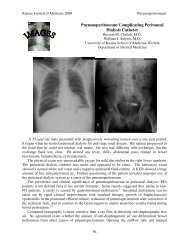The Silence of Neurosyphilis - Archie Home
The Silence of Neurosyphilis - Archie Home
The Silence of Neurosyphilis - Archie Home
Create successful ePaper yourself
Turn your PDF publications into a flip-book with our unique Google optimized e-Paper software.
Kansas Journal <strong>of</strong> Medicine 2011 <strong>The</strong> <strong>Silence</strong> <strong>of</strong> <strong>Neurosyphilis</strong><br />
months and may be diagnosed if the CSF<br />
white blood count is more than 5 cells/µL or<br />
protein more than 45 mg/dL.<br />
Symptomatic neurosyphilis usually<br />
occurs within the first year after infection<br />
and may present with typical meningitis-like<br />
symptoms, such as headache, nausea,<br />
vomiting, altered mental status or confusion,<br />
audiovisual impairments, and stiff neck. 8<br />
Patients also may develop arteritis with<br />
small, medium, or large vessel disease<br />
potentially causing ischemia or infarction <strong>of</strong><br />
brain and/or spinal parenchyma and gummas<br />
that may induce seizures.<br />
Late neurosyphilis may present with<br />
general paresis and tabes dorsalis. 8 General<br />
paresis may have a normal neurologic<br />
examination but common abnormal findings<br />
include dysarthria, intention tremors <strong>of</strong> the<br />
face, tongue, and hands, as well as reflex<br />
abnormalities. Cerebrospinal fluid will<br />
show a reactive Venereal Disease Research<br />
Laboratory (VDRL) result <strong>of</strong> 25 to 75<br />
cells/µL lymphocytes and 50 to 100 mg/dL<br />
protein. Atrophy is seen on neuroimaging.<br />
Tabes dorsalis is a process that usually<br />
does not manifest until 20 years post<br />
infection and involves the dorsal columns<br />
and dorsal roots <strong>of</strong> the spinal cord. 8 Patients<br />
present with sensory abnormalities and/or<br />
lancinating pains affecting the face, back or<br />
limbs. Patients also may develop<br />
paresthesias, absent lower extremity<br />
reflexes, depressed vibratory and position<br />
sensation, attenuated touch and pain, and<br />
gastric crises which manifest as recurrent<br />
nausea, vomiting with severe epigastric<br />
pain. Argyll-Robertson pupils is one <strong>of</strong> the<br />
most common presentation in tabes dorsalis,<br />
and less so in general paresis. CSF may be<br />
normal or show 10 to 50 cells/µL<br />
lymphocytes and 45 to 75 mg/dL protein.<br />
Our patient had a positive rapid plasma<br />
reagin with positive IgG and negative IgM<br />
syphilis antibodies representing active or<br />
recently treated syphilis. CSF findings also<br />
115<br />
supported a diagnosis <strong>of</strong> late neurosyphilis.<br />
Clinically, the patient had a stroke<br />
secondary to a vascular occlusion to the left<br />
middle cerebral artery. <strong>The</strong> etiology <strong>of</strong> the<br />
vaso-occlusion is uncertain but most likely<br />
leans towards a vasculitis secondary to<br />
syphilis. <strong>The</strong> T. pallidum aggregate around<br />
any subarachnoid vessel, surrounding the<br />
brain or spinal cord, causes an influx <strong>of</strong><br />
lymphocytes and plasma cells which<br />
infiltrate the arterial wall and perivascular<br />
tissue. 8 As the infectious inflammation<br />
progresses, the potential cascade <strong>of</strong><br />
vasoconstriction complicated with vascular<br />
obliteration occurs after the release <strong>of</strong> prothrombotic<br />
reactants by the damaged<br />
vascular endothelium (Figure 3).<br />
Our patient had peripheral neuropathy<br />
described as paresthesia, absent lower<br />
extremity reflexes with decreased sensation.<br />
His depressed level <strong>of</strong> sensorium did not<br />
allow him to recognize that he had suffered<br />
from frostbite and gangrene. He also<br />
complained <strong>of</strong> food tasting awful associated<br />
with nausea and vomiting. <strong>The</strong> constellation<br />
<strong>of</strong> symptoms manifested by our patient may<br />
fall under the umbrella <strong>of</strong> tabes dorsalis,<br />
amongst other possible diagnoses. A reliable<br />
history from this patient was difficult to<br />
ascertain, especially regarding how recently<br />
he had been infected with syphilis.<br />
<strong>The</strong>refore, the possible diagnosis <strong>of</strong> tabes<br />
dorsalis cannot be ruled out.<br />
Conclusion<br />
Meningosyphilis is an uncommon cause<br />
<strong>of</strong> stroke in the post-antibiotic era. In<br />
untreated neurosyphilis, meningosyphilis is<br />
found in 10% <strong>of</strong> cases. 9 Its pathophysiology<br />
involves vasculitis <strong>of</strong> any vessel in the<br />
subarachnoid space with extension into the<br />
perivascular tissue resulting with ischemia<br />
and infarct. Diagnosis is made with a<br />
positive CSF-VDRL test and treatment is<br />
18-24 million units <strong>of</strong> penicillin G infused<br />
daily for two weeks. 3











